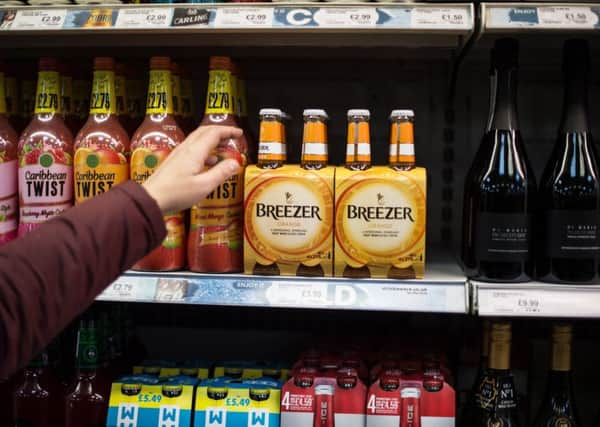Alcohol sales see major drop across Scotland as minimum pricing hits


Sales of cider fell the most, down 18.6 per cent, while sales of spirits dropped by 3.8 per cent. Overall drink sales in Scotland reducing by 3.6 per cent. Public health minister Joe FitzPatrick said: “We are clearly moving in the right direction.”
The minimum price of 50 pence per unit was introduced in Scotland in May 2018. A report out today by NHS Health Scotland shows that sales in shops and supermarkets were down during the first year of operation.
Advertisement
Hide AdAdvertisement
Hide AdAnalysis of off-licence sales over the year following the 50p per unit limit being introduced showed a 3.6 per cent drop in the volume of pure alcohol being sold per adult in Scotland, from 7.4 to 7.1 litres.
This is equivalent to a reduction of 26 units each annually – around 12 pints of average strength beer, the NHS Scotland report finds.
But the sales still equate to every adult in Scotland drinking around 27 bottles of vodka a year and consumption remains higher then elsewhere in the UK.
Mr FitzPatrick said: “This is a promising first full year of data, following our world-leading action to introduce minimum unit pricing (MUP).
“The 3.6 per cent fall per adult in off-trade sales shows we are clearly moving in the right direction, particularly when compared to England and Wales, where there was a rise of 3.2 per cent.”
He added: “We have seen a change in the average price of alcohol, with the average price per unit rising by approximately 5p in Scotland compared to England and Wales.
“While the impact of reduced consumption will take a little longer to show, I remain convinced MUP is one of the main drivers in reducing alcohol harm.”
It comes after a separate NHS report last week found underage drinking had not fallen as a result of the policy. Many of the drinks favoured by young Scots, such as the tonic wine Buckfast, were not affected as they already cost more than 50p per unit minimum set by SNP ministers.
Advertisement
Hide AdAdvertisement
Hide AdThe Scottish Government also wants UK ministers to bring in a 9pm watershed for alcohol adverts or devolve the necessary power to Scotland, saying this would enable further protection from alcohol.
MSPs first passed legislation to introduce minimum pricing in Scotland in 2012, but it was held up in the courts for years after a challenge by the alcohol industry.
Scotland’s unhealthy relationship with alcohol had contributed to the country’s “sick man of Europe” reputation and the policy aimed to reduce the consumption of problem drinkers by raising the price of the strongest, cheapest alcohol.
The findings indicate an average rise in price of 5p per unit to 60p immediately following the minimum unit pricing change.
Spirits were down 3.8 per cent, wine fell 3 per cent and beer sales dropped 1.1 per cent.
Beer and spirits both rose 6p per unit on average, to 57p and 58p respectively, while wine jumped by 14p to around 61p.
The amount of alcohol bought at off-licences in England and Wales increased over the same period, up 6.3 per cent to 6.5 per cent, but remained lower than Scottish sales.
South of the Border, sales per adult rose 8.2 per cent for cider, 7 per cent for beer and 5.6 per cent for spirits, but fell 1.3 per cent for wine and 11.2 per cent for fortified wine.
Advertisement
Hide AdAdvertisement
Hide AdLucie Giles, public health intelligence adviser at NHS Health Scotland, said: “This is the first time we have been able to analyse sales data covering the full year following the introduction of MUP and it is encouraging that off-trade alcohol sales fell in Scotland following its implementation.”
Alison Douglas, chief executive of Alcohol Focus Scotland, described the findings as “great news”.
She said: “It’s encouraging to see that, as expected, consumers appear to be buying less cheap, high strength cider.”